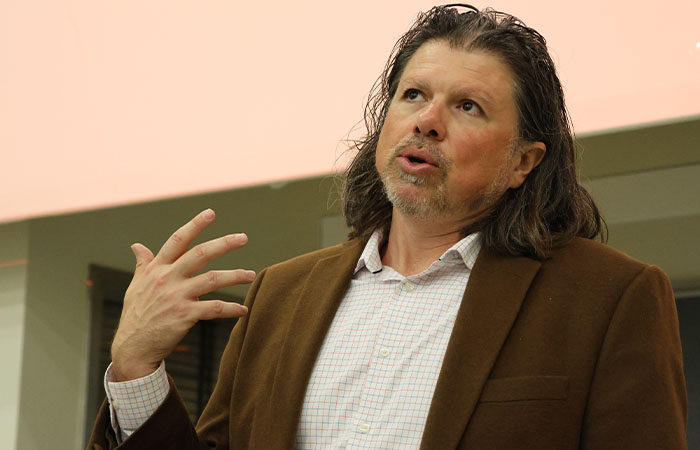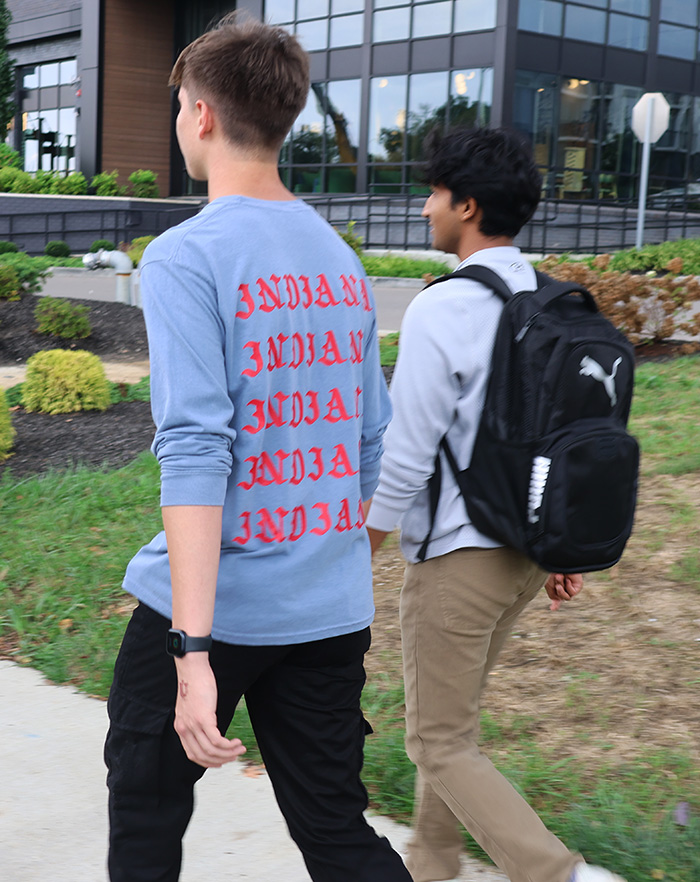Stella Abodeely

I am a sophomore from San Francisco, California majoring in Sports Marketing and Management and minoring in Sports Media and Business. I am also a coxswain on Indiana's Rowing Team.
By Caitlin Givand, Aaralyn Mills, Stella Abodeely
BLOOMINGTON, Ind. (November 5, 2024)
College athletics is undergoing major changes following NCAA legislation recently passed. The impact on former and current collegiate athletes with regard to name, image and likeness (NIL) leaves many athletes unfairly compensated.
Over the past few years, the sphere of college athletics has undergone transformations surrounding NIL, sparking debate concerning whether former athletes deserve payment for their contributions to their athletic departments. For example, Skip Mills, a former Ball State basketball player, aided the department in significant growth averaging 18.6 points per game in the 2005-2006 season. However, no financial compensation was awarded to Mills as he was considered an “amateur athlete” during his collegiate career. Some current players with similar, or less impressive statistics are being compensated handsomely for their efforts, which some see as unjust.
Indiana sports media professor Dr. Galen Clavio discusses the impact that a social media presence can have on an athlete’s value both in college and beyond. “Well now, if you’re a female athlete and you have some juice in the marketplace because you have a large social media following, you have the ability to capitalize on that yourself,” Clavio said.

This shift has brought many cases to light in the new era of NIL. Caitlin Clark, was a top recruit coming from the University of Iowa is a good example. Her stats paired with her social media presence allowed her to gain exposure through advertisements. Notably, her campaigns with Nike, Statefarm and Gatorade resulted in large payouts for Clark, something unfathomable for a college athlete years ago. A current senior on the Indiana University rowing team, Phoebe Inall, discusses the competitiveness between athletes and how those with large NIL deals behave. “The ones who are making a lot of money- they think they are so much better than the ones who are not, which is leading to a divide between student-athletes as well,” Inall said.
Even though many see this implementation of NIL strictly as a benefit for student-athletes, a majority of non-revenue sports athletes are facing negative repercussions in this transition. Indiana University senior rowing coxswain Lilly Gintert has experienced this firsthand. “I think that with all the changes that happened too, like Tobias and everything, the ones who are making NIL don’t even care about it because they don’t need to but it is impacting the sports that don’t make as much money,” Gintert said.

At Indiana University, Tobias Nutrition Center (TNC) is the exclusive athlete dining hall located at Memorial Stadium, offering a variety of nutrition options and to-go containers for the typical student-athlete in a rush from practice. In years prior, athletes were able to eat breakfast in TNC for free, giving them the ability to perform better throughout the day with easier access to a satisfying breakfast. However, starting this year, to pay funds to the NCAA for NIL settlements, IU Athletics has started charging student-athletes for meals, with breakfast increasing $10 from before. Due to this, many athletes do not use the nutrition center anymore and struggle to fuel after workouts.
Clavio mentions the importance and urgency of the NCAA passing this significant piece of legislature. “One of the reasons why the NCAA is trying to get this settlement put in the books is they lock out previous potential classes of athletes from being able to sue for lost funds or lost compensation,” Clavio said.
NIL has reshaped the college sports landscape, allowing athletes to profit from their talents unlike before. For athletes like Skip Mills, a former All-MAC Ball State University basketball player from 2003-2006, this opportunity to profit from personal branding was non-existent. “My dad used to tell me, if I could get a hit, he would give me five or ten dollars. Knowing that, if NIL was there when I was in college, it definitely would have made me more motivated,” Mills said.
FOR IMMEDIATE RELEASE
Media Contacts
Ethan Bonheur
Daisy Desilvia
Stella Abodeely
Apple’s press conference on Tuesday unveils their newest product, the Apple Watch, announced by CEO Tim Cook in Cupertino, California, highlighting the innovative future of the device. Cook, proud of the launch and optimistic about the future of the product and brand, sports the new watch while wearing a casual outfit.
The announcement made at the Flint Center located at De Anza College is explained by Cook as a pivotal moment in influencing customers’ lives and changing their views on such a product. After playing the intro video, Cook steps back onto the stage, arm held high, showing the new, innovative product on his wrist.
The Apple Watch is as precise as can be, matching and being synced to the universal time standard, as well as being customizable, giving users the ability to make the product their own and tailored to their needs and preferences. Along with its precision, it allows users to connect to their devices seamlessly while also doubling as a health and fitness device.

The functionality tools and methods for the device show and express the thoughtfulness behind the product. The digital crown, located on the side of the device, serves as a navigation device for the watch, offering zoom features on applications such as Maps, scrolling on a list, and helping you return to the home screen when exiting out of apps.
The flexible retina display alongside this dial allows the device to have a sleek, sophisticated look, further proving how the Apple Watch combines style and functionality. The variety and range of watch faces, colored bands, textured straps, and types of buckles continues giving users the ability to customize their experience. In addition, there are 3 collections. The traditional Apple Watch is in a polished case, the Apple Watch Sport has an aluminum shell that is stronger while still being light, and finally, the Apple Watch Edition which is made of hard, 18-karat gold. Touch and force differentiators make the device context-sensitive, and allow for a more positive user experience and increased functionality. All of this is made possible by the new S1 chip and taptic engine that allow for a device this small to have so much use.
The back crystal, responsible for tracking heart rate and fitness-related activities, also connects to the inductive charging powered by MagSafe, which doesn’t require alignment and makes the process easy for users.

Kevin Lynch, Vice President of Apple, made an appearance, giving a live demonstration of the device and its features. This aspect of the presentation presented the various tasks and customizable features the watch has, showing how easy it would be for any user to make this device truly their own. Connection to other devices such as the iPhone and MacBook are also pointed out by Lynch, highlighting how the watch can control certain functions such as playing music from these other products. Quick reply is also an integral feature relating to the ease of use of the watch, giving users a list of potential replies when receiving messages, and the ability to use animated emojis or audio text.
“We’ve also been working to enable third-party developers to extend their apps to Apple Watch,” Lynch points out, expressing this potential due to applications on the iPhone. The partnerships with other businesses, such as Starwood Hotels, giving watch wearers the ability to unlock their hotel door with a tap of their watch, shows their confidence in the watch and the potential it has to better the lives of customers. Other notable connections include Pinterest, American Airlines, and BMW.
Cook dives into what he considers to be one of the most important features of the watch: fitness. “We have two new applications in Apple Watch. First is the fitness app. The fitness app monitors all of your activity and movement throughout the day. And the second is the workout app. The workout app allows you to set specific goals for specific types of workouts like cycling or running,” notes Cook. A comprehensive, in-depth video shows the health impacts and ways the product will allow users to meet their fitness goals. “Apple Watch is designed to help anyone who wears it to lead a healthier life by being more active,” says Jay Blahnik, Director of Fitness, Health Technologies. He points out how this watch and its features are for everyone, from high-level athletes to those just starting their fitness journey.
“Apple Watch required some deep innovation. It’s a precise timepiece with incredible ability to customize. It’s a new, intimate way to communicate directly from your wrist, and it’s a comprehensive health and fitness device. And it is so much more.”
Apple Watch pairs with iPhone 6, iPhone 6 Plus, iPhone 5s, iPhone 5c, and iPhone 5, starting at a cost of $349 in early 2025.
CEO Tim Cook talks about how to charge the Apple Watch. The Apple Watch will lose a lot of battery throughout the day so it’s important to charge it every night.
Vice President Kevin Lynch describes how to access different apps on the Apple Watch. Like the iPhone, the Apple Watch has all of the same apps plus other health tracking apps including heart rate and daily steps.
###